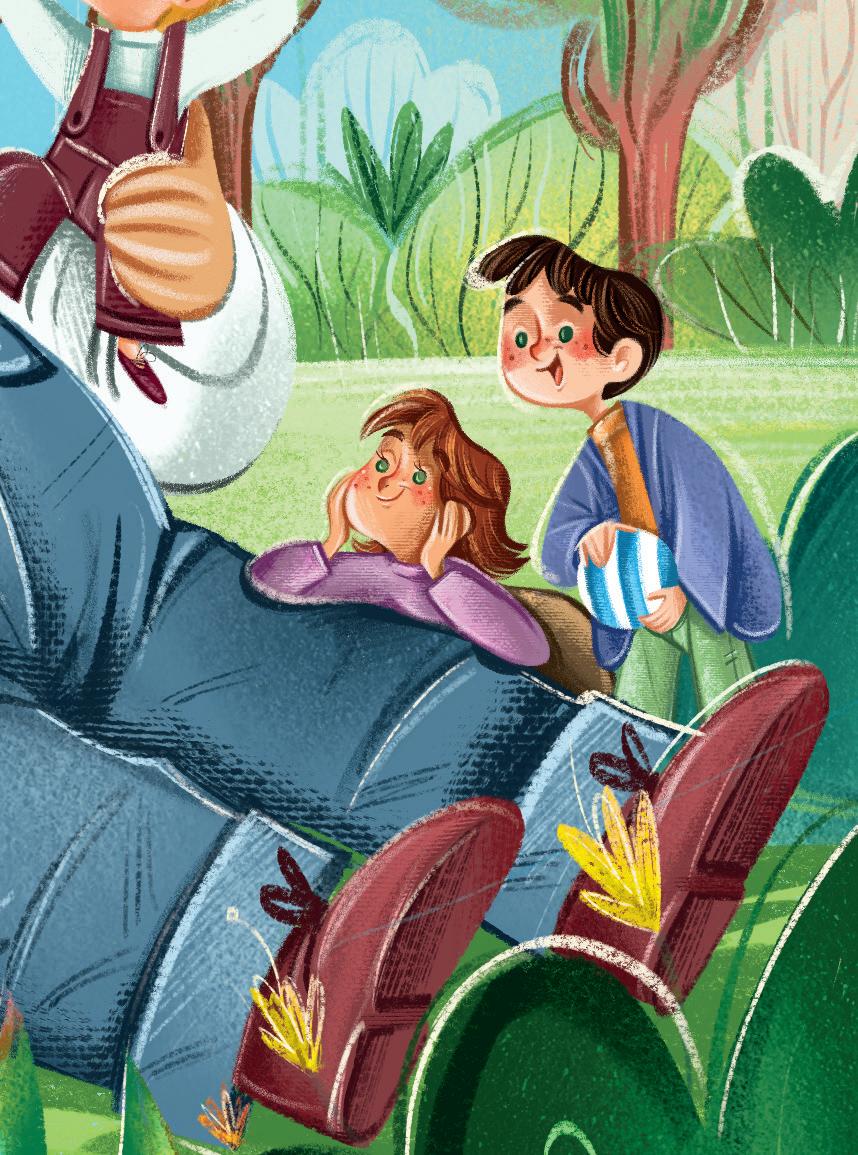Th e































































1 Inquadra il seguente QR code e attiva il libro digitale

2 E ettua l’accesso e inserisci il CODICE DI ATTIVAZIONE riportato nel riquadro
3 Clicca su e accedi agli audio e alle soluzioni


Hai bisogno di supporto? Scrivi a supporto@raffaellodigitale.it




















Retold by: Marisa Agostinelli
Elizabeth Evans Cicconi
Paola Traferro
Illustrated by: Elena Iarussi
Editorial staff: Francesca Ceppi, Clarissa Coppari
Graphic dept.: Simona Albonetti
Illustrations: Elena Iarussi
Referenze fotografiche: iStock photo, Shutterstock, photographic archive Gruppo Ed. Raffaello
Printed in Italy by: Gruppo Editoriale Raffaello
All rights reserved. No part of this publication may be reproduced, stored in a retrieval system, or transmitted, in any form or by any means, electronic, mechanical, photocopying, recording or otherwise without the prior written permission of the Publishers.
Every effort has been made to acknowledge correctly and contact the source and/or copyright holder of material used in this book.
The publishers apologize for any unintentional errors or omissions and will be pleased to make corrections in future editions of this book.
© 2023
Raffaello Libri S.p.A. Via dell’Industria, 21 60037 - Monte San Vito (AN) www.celticpublishing.com info@grupporaffaello.it
































































































































The Selfish Giant is a fairy tale written by Oscar Wilde in the 19th century. It is about a giant who has a beautiful garden full of flowers and with 12 peach trees. The children play there after school because the owner is away. When he returns, after seven years, they can’t play there anymore. So, they become very sad. But something strange happens: nothing grows there. Flowers don’t bloom and trees are bare. It’s always winter!
One day, though, spring comes again because the children could enter the garden from a hole. The giant sees that in a corner, winter is still there because a little boy can’t reach the branches of a tree. The giant understands that he is really selfish, he helps the boy and destroys the walls. The children notice the change in the giant and he starts playing with them.
Time flies and one day in winter, the old giant sees a tree with white blossoms in a corner and the wounded little boy on top of it. The giant asks who hurt him but the boy says it is the wounds of love. The boy asks the giant to come to his garden. The following day, the people find the giant dead under a tree filled with white blossoms.
1 Choose the right option (A, B or C).

What is a fairy tale?
A It is a story for children about mysterious events.




























































































B It is a story for children about magic and imaginary lands and people.


C It is a sci-fi story.



































2 Read and tick true (T), false (F) or not given (NG).
1. When the Giant comes back, the children can play in his garden. T F NG





2. There are flowers all the year long when he returns. T F NG
3. The children could go to the garden through a hole. T F NG
4. The little boy has blue eyes and blonde hair. T F NG
5. The Giant dies in his house. T F NG
3 Now answer the following questions.








1. Who wrote the Selfish Giant?
2. When was this fairy tale written?
3. How many peach trees has the giant got in his garden?
4. Who plays in his garden?

5. Can the children play in his garden when he returns?






















Oscar Wilde (full name Oscar Fingal O’Flahertie Wills Wilde) was born in Dublin, Ireland on 16th October 1854. His dad was a well-known surgeon as well as a writer. His mum was a poet and a scholar of Celtic myth and folklore.

When he was a student, Oscar Wilde had a scholarship and went to Trinity College in Dublin, Ireland, from 1871 to 1874 and then to Magdalen College at the University of Oxford in England, from 1874 to 1878.


In 1878, before finishing university, he won the Oxford’s Newdigate Prize for his long poem Ravenna.



Oscar Wilde was interested in the importance of art in life.

Oscar of art



He was really eccentric, he usually wore a velvet jacket, knee breeches, and black silk stockings.




In 1884 he married Constance Lloyd. The couple had two sons. He wrote book reviews and in 1888 published The Happy Prince and Other Tales, a romantic allegory (a story with more than one meaning) in the form of a fairy tale. In this work we find The Selfish Giant, too. During the 1890s, Oscar Wilde published his famous works. Right in 1890, he published his only novel The picture of Dorian Gray, which mirrors the author’s opinion on life and art.



The novel, in fact, is about the life of a young man who has eternal youth at the expense of his soul. The book was considered immoral.
In 1891 he wrote a lot like Lord Arthur Savile’s Crime, Intentions and Other Stories and A House of Pomegranates. Wilde was very famous for his plays. His first success was Lady Windermere’s Fan in 1892.
An Ideal Husband and The Importance of Being Earnest, his last ones were published in 1895.



In The Importance of Being Earnest Wilde wanted to criticize the Victorian Era and its hypocrisy.
Wilde’s life was always reckless. His last years are an example. He died on November 30th, 1900, in Paris.






He is very big. He doesn’t care about the others. He is the protagonist.






They are other characters in the story because they play in the Giant’s garden.




He is another important character in the story. The Giant helps him to reach the top of a tree.


















Every day after school, the children went to the Giant’s garden to play. It was a beautiful garden, with soft green grass. There were lots of colourful flowers and twelve peach trees. In spring, the trees were covered with pink and white blossoms.

soft: morbida/morbido
peach trees: alberi di pesco
blossoms: fiori

In autumn they were covered with fruit. The birds sat on the trees and sang so sweetly that the children sometimes stopped their games to listen to them. “We are happy!” said the children every day. One day the Giant came back from a seven-year visit to his friend, the Cornish Ogre.




sweetly: dolcemente
giant: gigante
Cornish Ogre: Orco della Cornovaglia
(to) mirror: rispecchiare
noon: mezzogiorno
novel: romanzo
owner: proprietario
postcards: cartoline
(to) preserve: salvaguardare
reckless: spericolata
red with anger: rosso di rabbia
restoring: ripristinare
roof: tetto
scholar: studioso
scholarship: borsa di studio
sci-history: fantascienza
selfish: egoista
shell grotto: grotta di conchiglie
soul: anima
stunning: stupendo
surgeon: chirurgo
Goals: Obiettivi di Sviluppo
Sostenibile
tiny: piccolissimo
unknown: sconosciuto
velvet: velluto
wall: muro
was over: era finita
waves: onde
wood: legno
wounded: ferito
youth: giovinezza


Può un progetto scolastico su una lampada fatta con materiali di riciclo far stringere amicizie e combattere pregiudizi e bullismo? Sì, può farlo. È quanto accade a Steve e alle sue vecchie e nuove conoscenze, in nome di una nuova e bellissima amicizia.
LEVEL 4
Pagine: 56
ISBN: 978-88-472-4105-3
CEF A1

Nella Londra di fine ‘800 Phileas Fogg, un gentleman metodico e rigoroso, scommette con i suoi amici di riuscire a fare il giro del mondo in 80 giorni. Partito con il suo fedele valletto Passepartout, affronterà molte avventure e incontrerà personaggi eccentrici in questa corsa contro il tempo per vincere la scommessa. Un classico della letteratura di avventura.
Pagine: 64
ISBN: 978-88-472-4104-6
LEVEL 5
CEF A2

Il famoso scrittore Prof. Whittley viene trovato seriamente ferito, nella sua abitazione al centro di Londra. Chi può essere stato?
Il caso, difficile da risolvere, verrà districato minuziosamente dall’ispettore Mackay, che aiutato dall’assistente Harris e dal cagnolino Ollie, giungerà alla verità.
Pagine: 64
ISBN: 978-88-472-4107-7



LEVEL 5
CEF A2+

Un classico di Oscar Wilde: il gigante egoista impedisce ai bambini di giocare nel suo bellissimo giardino; ma quando un piccolo bambino diverso dagli altri entra nel giardino, il cuore del gigante viene toccato e lui cambia le sue abitudini. La storia insegna una lezione di gentilezza e accettazione.
Linguaggio semplice e calibrato al livello di studio della lingua A1/A2


Attività di comprensione del testo ed esercizi di riflessione linguistica
Approfondimenti culturali, CLIL e di educazione civica (Agenda 2030)
Ascolti con QR code e nel Libro digitale
www.celticpublishing.com